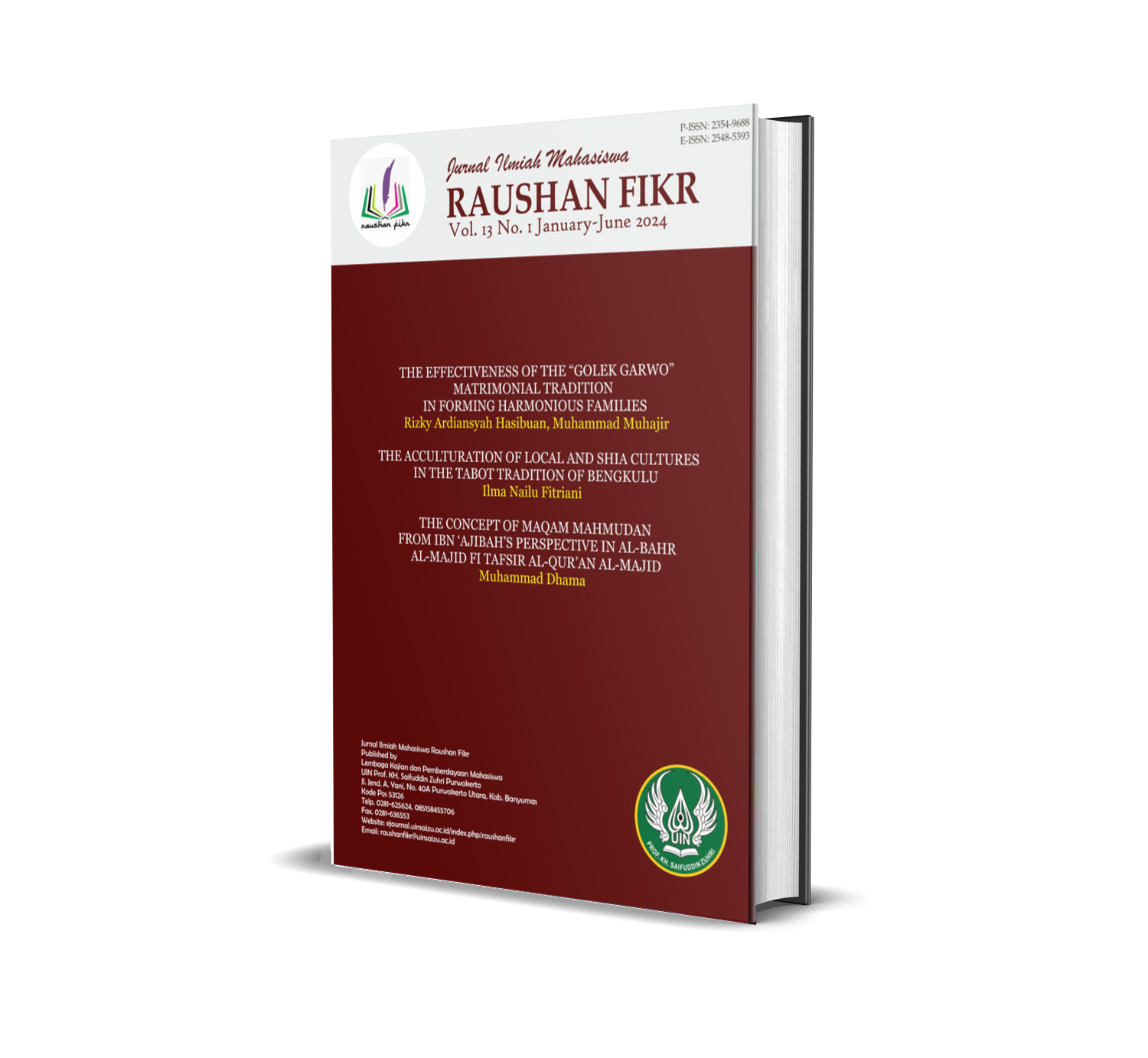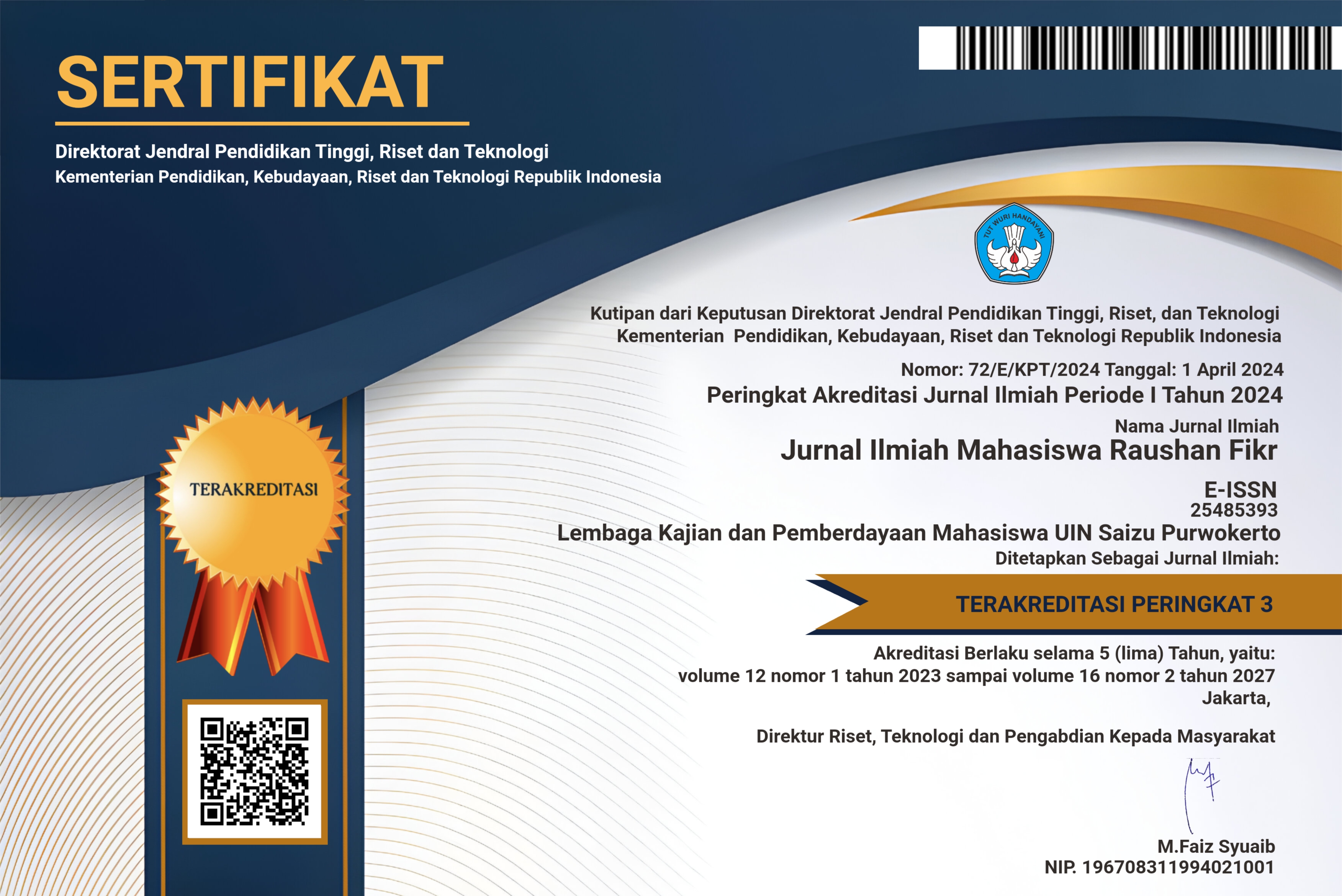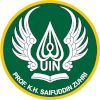The Concept of Maqam Mahmud from Perspective of ibn Ajib ah Perspective in Al Bahr Al Madid fi Tafsir Al-Qur’an Al Majid
DOI:
https://doi.org/10.24090/jimrf.v13i1.11217Keywords:
Maqaman Mahmudan, Ibn Ajibah, Tafsir Al BahrAbstract
This study investigates Ibn Ajibah’s concept of maqaman mahmudan in his exegesis, Al Bahr Al Madid Fi Tafsir Al-Qur'an Al Majid, emphasizing its spiritual significance in Islam. Traditionally, maqaman mahmudan denotes an esteemed status attributed to Prophet Muhammad, with varying interpretations regarding the means of its attainment. Ibn Ajibah contends that this rank is achieved through unwavering dedication and sustained effort, challenging conventional interpretations. Using semiotic textual analysis, this research contextualizes the verse socio-historically, deconstructs traditional views, and reconstructs them within contemporary frameworks. It highlights the theological and practical implications, affirming that maqaman mahmudan is an exclusive attribute of Prophet Muhammad, unattainable by ordinary individuals. The study advocates for a deeper exploration into achieving maqaman mahmudan through consistency and perseverance, offering insights into its spiritual significance and contemporary relevance.Downloads
References
Abdul-Hamid, W. K. (2015). Integration of religion and spirituality into trauma psychotherapy: An example in sufism? Journal of EMDR Practice and Research, 9(3), 150–156. https://doi.org/10.1891/1933-3196.9.3.150
Abduloh, A. Y., & Ahyani, H. (2020). Pendidikan hati menurut Al-Ghazali (Keajaiban hati: Penjelasan tentang perbedaan antara dua maqom). Jurnal Tawadhu, 4(2), 1209–1227.
Abshor, M. U. (2020). Dzikir dalam Tafsir Sufi Ibnu Ajibah (al-Bahr al-Madid fi Tafsir al-Qur’an al-Madid). Jurnal Ilmiah Ilmu Ushuluddin, 19(1), 41–55.
Al-Maqam dan Al-Ahwal dalam Tasawuf | Jurnal Usuluddin. (n.d.). Retrieved May 19, 2024, from https://mjlis.um.edu.my/index.php/JUD/article/view/5078
Arbaoui, A., Alginahi, Y. M., & Menacer, M. (2013). Strategies for Collecting Electronic Resources on the Qur’anic Researches. QUR’ANICA-International Journal of Qur’anic Research, 4(1), 57–78.
Arsad, M. (2018). Pendekatan Dalam Tafsir (Tafsir Bi Al Matsur, Tafsir Bi Al Rayi, Tafsir Bi Al Isyari). Yurisprudentia: Jurnal Hukum Ekonomi, 4(2), 147–165.
Brown, J. A. C. (2012). Faithful Dissenters: Sunni Skepticism about the Miracles of Saints. Journal of Sufi Studies, 1(2), 123–168. https://doi.org/10.1163/22105956-12341238
Budiono, A. (2015). Penafsiran Al-Qur’an Melalui Pendekatan Semiotika Dan Antropologi (Telaah Pemikiran Muhammad Arkoun). MIYAH: Jurnal Studi Islam, 11(2), 281–306.
El-Rouayheb, K. (2010). Heresy and Sufism in the Arabic-Islamic world, 1550-1750: Some preliminary observations. Bulletin of the School of Oriental and African Studies, 73(3), 357–380. https://doi.org/10.1017/S0041977X10000376
Fauzi, M. I. F. (2022). Konsep Pemikiran Pendidikan Sufisme Menurut Ibnu Athaillah As-Sakandari Studi Kitab Al-Hikam. JISPENDIORA Jurnal Ilmu Sosial Pendidikan Dan Humaniora, 1(1), 82–93.
Fauzi, R. (2023). Bentuk-bentuk Ma’rifatullah dalam Interpretasi Al-Hizb Al-Rabi’ Syaikh Ahmad bin Idris al-Fasi. Hikamia: Jurnal Pemikiran Tasawuf Dan Peradaban Islam, 3(1), 50–59.
Firdaus, S. (2016). Tafsir sufi: Kajian analitikal Terhadap kitab tafsira al-Bahr al-Madid fi tafsir al-Qur’an al-Majid oleh Ibn Ajibah (1160-1224 H)/Firdaus Sulaiman.
Green, N. (2004). Emerging Approaches to the Sufi Traditions of South Asia: Between Texts, Territories and the Transcendent. South Asia Research, 24(2), 123–148. https://doi.org/10.1177/0262728004047908
Griffel, F. (2009). Al-Ghazali’s Philosophical Theology. In Al-Ghazali’s Philosophical Theology (p. 422). https://doi.org/10.1093/acprof:oso/9780195331622.001.0001
Hairul, M. A. (2017). Mengkaji Tafsir Sufi Karya Ibnu ‘Ajibah.
Hamka. (1983). Tafsir Al-Azhar (Juz 1). Jakarta: Pustaka Panjimas.
Hanafi, N. I. B. M. N. (2019). Konsep Ilmu Dalam Tafsir al-Bahr al-Madid Fi Tafsir Al-Qur’an Al-Majid Karya Ibn ‘Ajibah (1160-1224 H).
Hashim, M. (2022). Uzlah and Dhikr in Sufi Ishari’s Exegesis Al-Bahr Al-Madid by Ibn Ajibah. Afkar, 24(1), 33–64. https://doi.org/10.22452/afkar.vol24no1.2
Hermansen, M. (2009). Global Sufism: “Theirs and ours.” Sufis in Western Society: Global Networking and Locality, (Query date: 2024-06-08 11:25:30), 26–45. https://doi.org/10.4324/9780203883648
Ibn al-Arab, 1165-1240. (1852). Al-Futuhat al-Makkiyah. Bulaq Dar al-tiba’ah al-bahirah. Retrieved from http://archive.org/details/alfutuhatalmakki13ibnauoft
ibn Ajibah al-Hasani, M. (1224). Al-Bahr al-madid fi tafsir al-Qurʼan al-Majid (Jilid 1). Al-Qahirah: Taba’a ala Nafaqahu Hasan Abbas Zaki.
Idrees, H. (2011). Classification of library materials on Islam: A literature survey. OCLC Systems & Services: International Digital Library Perspectives, 27(2), 124–145.
Isbah, F., & Ula, M. (2022). Dimensi Tasawuf dalam Ilmu Nahwu: Kajian Kitab Al-Futuhat al-Quddusiyyah fi Syarh al-Muqaddimah al-Jurumiyyah Karya Ibn Ajibah. Journal of Sufism and Psychotherapy, 2(1), 89–106.
Kau, S. A. (2014). Hermeneutika Gadamer dan Relevansinya dengan Tafsir. Farabi, 11(2), 109–123.
Khoiruddin, M. A. (2016). Peran Tasawuf Dalam Kehidupan Masyarakat Modern. Tribakti: Jurnal Pemikiran Keislaman, 27(1), 113 ~ 130-113 ~ 130. https://doi.org/10.33367/tribakti.v27i1.261
Kuru, Z. (2008). Apolitical interpretation of Islam: Said Nursi’s faith-based activism in comparison with political Islamism and Sufism. Islam and Christian-Muslim Relations, 19(1), 99–111. https://doi.org/10.1080/13510340701770311
Lewisohn, L. (1998). An introduction to the history of modern Persian Sufism, Part I: The Ni’matullahi order: Persecution, revival and schism. Bulletin of the School of Oriental and African Studies, 61(3), 437–464. https://doi.org/10.1017/s0041977x00019285
Malaka, A. (2021). Berbagai Metode dan Corak Penafsiran Al-Qur’an. Bayani, 1(2), 143–157.
Melchert, C. (2014). Origins and early sufism. The Cambridge Companion to Sufism, (Query date: 2024-06-08 11:25:30), 3–23. https://doi.org/10.1017/CCO9781139087599.003
Muhammad al-Zamakhsyari, A. al-Q. J. A. M. bin U. bin. (1995). Tafsir al- Kasysyaf. Beirut: Dar al-Kutub al-Ilmiyyah.
Muslihin, M. (2023). Rekonstruksi Jihad Dalam Tafsir Ibn Ajibah: Studi Atas Tafsir Al-Bahr Al-Madid Fi Tafsir Al-Qur’an Al-Majid. Tanzil: Jurnal Studi Al-Qur’an, 5(2), 183–202.
Qasim, H. M., & Akhtar, D. N. A. (2019). ابنِ عجیبہ کا نظریۂ شریعت و طریقت: ایک مطالعہ : A Study of Ibn Ajibah’s Theory of Shariʻah and Ṭariqah. Al-Qamar, 223–234.
Rosenthal, G. (2004). Biographical research. Qualitative Research Practice, 48–64.
Sayfulina, F. (2013). Contemporary issues of textual analysis of turkic-tatar literary monuments of western Siberia. World Applied Sciences Journal, 27(13), 492–496. https://doi.org/10.5829/idosi.wasj.2013.27.elelc.101
Seesemann, R. (2009). “Being as good Muslims as Frenchmen”: On Islam and colonial modernity in West Africa. Journal of Religion in Africa, 39(1), 91–120. https://doi.org/10.1163/157006609X409067
Sharifian, F. (2021). Cultural Linguistics and religion. Cognitive Linguistic Studies in Cultural Contexts, 14(Query date: 2024-06-08 11:25:30), 9–22. https://doi.org/10.1075/clscc.14.02sha
Shihab, Q. (2000). Tafsir Al-Misbah (Jilid 1). Jakarta: Lentera Hati.
SI1981. (2022). Tafsir Ath Thabari Jami’ Al Bayan Fi Ta’wil Al Qur’an Terjemah Bahasa Indonesia. Retrieved from http://archive.org/details/tafsir-1_202201
Sopian, A., Zakiah, U. S. S., & Abdulkhaleq, A.-R. (2022). Analysis of Pierce’s Semiotic Perspective in the Terminology of Nahwu. Izdihar: Journal of Arabic Language Teaching, Linguistics, and Literature, 5(2), 117–134.
Varma, S. (2016). Love in the time of occupation: Reveries, longing, and intoxication in Kashmir. American Ethnologist, 43(1), 50–62. https://doi.org/10.1111/amet.12262
Wahyuni, D. N. (2023). Makna Sakinah dalam Al-Qur’an Telaah terhadap Al-Bahr Al-Madid Ibn Ajibah (bachelorThesis, FU). FU. Retrieved from https://repository.uinjkt.ac.id/dspace/handle/123456789/66661
Downloads
Published
How to Cite
Issue
Section
License
Copyright (c) 2024 Muhammad Dhama

This work is licensed under a Creative Commons Attribution-NonCommercial-ShareAlike 4.0 International License.
Authors who publish with this journal agree to the following terms:
- Authors retain copyright and grant the journal right of first publication with the work simultaneously licensed under a Creative Commons Attribution-NonCommercial-ShareAlike 4.0 International License that allows others to share the work with an acknowledgement of the work's authorship and initial publication in this journal.
- Authors are able to enter into separate, additional contractual arrangements for the non-exclusive distribution of the journal's published version of the work (e.g., post it to an institutional repository or publish it in a book), with an acknowledgement of its initial publication in this journal.
- Authors are permitted and encouraged to post their work online (e.g., in institutional repositories or on their website) prior to and during the submission process, as it can lead to productive exchanges, as well as earlier and greater citation of published work (See The Effect of Open Access).
















